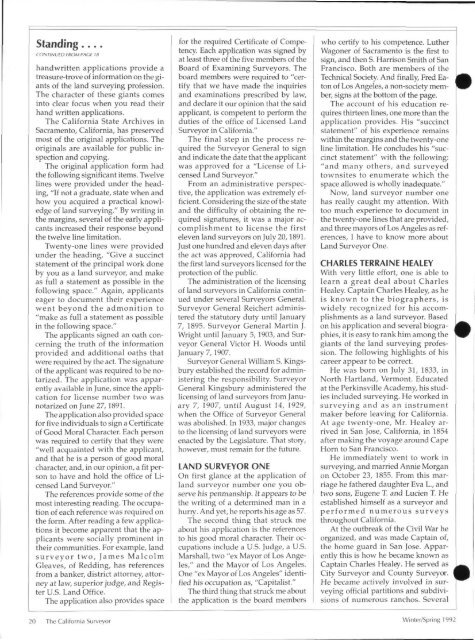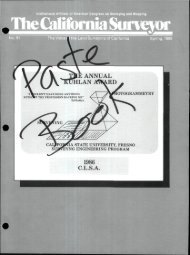Create successful ePaper yourself
Turn your PDF publications into a flip-book with our unique Google optimized e-Paper software.
Standing....<br />
CONTINUED FROM PAGE 18<br />
handwritten applications provide a<br />
treasure-trove of in<strong>for</strong>mation on the giants<br />
of the land surveying profession.<br />
<strong>The</strong> character of these giants comes<br />
into clear focus when you read their<br />
hand written applications.<br />
<strong>The</strong> Cali<strong>for</strong>nia State Archives in<br />
Sacramento, Cali<strong>for</strong>nia, has preserved<br />
most of the original applications. <strong>The</strong><br />
originals are available <strong>for</strong> public inspection<br />
and copying.<br />
<strong>The</strong> original application <strong>for</strong>m had<br />
the following significant items. Twelve<br />
lines were provided under the heading,<br />
"If not a graduate, state when and<br />
how you acquired a practical knowledge<br />
of land surveying." By writing in<br />
the margins, several of the early applicants<br />
increased their response beyond<br />
the twelve line limitation.<br />
Twenty-one lines were provided<br />
under the heading, "Give a succinct<br />
statement of the principal work done<br />
by you as a land surveyor, and make<br />
as full a statement as possible in the<br />
following space." Again, applicants<br />
eager to document their experience<br />
went beyond the admonition to<br />
"make as full a statement as possible<br />
in the following space."<br />
<strong>The</strong> applicants signed an oath concerning<br />
the truth of the in<strong>for</strong>mation<br />
provided and additional oaths that<br />
were required by the act. <strong>The</strong> signature<br />
of the applicant was required to be notarized.<br />
<strong>The</strong> application was apparently<br />
available in June, since the application<br />
<strong>for</strong> license number two was<br />
notarized on June 27,1891.<br />
<strong>The</strong> application also provided space<br />
<strong>for</strong> five individuals to sign a Certificate<br />
of Good Moral Character. Each person<br />
was required to certify that they were<br />
"well acquainted with the applicant,<br />
and that he is a person of good moral<br />
character, and, in our opinion, a fit person<br />
to have and hold the office of Licensed<br />
Land <strong>Surveyor</strong>."<br />
<strong>The</strong> references provide some of the<br />
most interesting reading. <strong>The</strong> occupation<br />
of each reference was required on<br />
the <strong>for</strong>m. After reading a few applications<br />
it become apparent that the applicants<br />
were socially prominent in<br />
their communities. For example, land<br />
surveyor two, James Malcolm<br />
Gleaves, of Redding, has references<br />
from a banker, district attorney, attorney<br />
at law, superior judge, and Register<br />
U.S. Land Office.<br />
<strong>The</strong> application also provides space<br />
<strong>for</strong> the required Certificate of Competency.<br />
Each application was signed by<br />
at least three of the five members of the<br />
Board of Examining <strong>Surveyor</strong>s. <strong>The</strong><br />
board members were required to "certify<br />
that we have made the inquiries<br />
and examinations prescribed by law,<br />
and declare it our opinion that the said<br />
applicant, is competent to per<strong>for</strong>m the<br />
duties of the office of Licensed Land<br />
<strong>Surveyor</strong> in Cali<strong>for</strong>nia."<br />
<strong>The</strong> final step in the process required<br />
the <strong>Surveyor</strong> General to sign<br />
and indicate the date that the applicant<br />
was approved <strong>for</strong> a "License of Licensed<br />
Land <strong>Surveyor</strong>."<br />
From an administrative perspective,<br />
the application was extremely efficient.<br />
Considering the size of the state<br />
and the difficulty of obtaining the required<br />
signatures, it was a major accomplishment<br />
to license the first<br />
eleven land surveyors on July 20,1891.<br />
Just one hundred and eleven days after<br />
the act was approved, Cali<strong>for</strong>nia had<br />
the first land surveyors licensed <strong>for</strong> the<br />
protection of the public.<br />
<strong>The</strong> administration of the licensing<br />
of land surveyors in Cali<strong>for</strong>nia continued<br />
under several <strong>Surveyor</strong>s General.<br />
<strong>Surveyor</strong> General Reichert administered<br />
the statutory duty until January<br />
7, 1895. <strong>Surveyor</strong> General Martin J.<br />
Wright until January 5, 1903, and <strong>Surveyor</strong><br />
General Victor H. Woods until<br />
January 7,1907.<br />
<strong>Surveyor</strong> General William S. Kingsbury<br />
established the record <strong>for</strong> administering<br />
the responsibility. <strong>Surveyor</strong><br />
General Kingsbury administered the<br />
licensing of land surveyors from January<br />
7, 1907, until August 14, 1929,<br />
when the Office of <strong>Surveyor</strong> General<br />
was abolished. In 1933, major changes<br />
to the licensing of land surveyors were<br />
enacted by the Legislature. That story,<br />
however, must remain <strong>for</strong> the future.<br />
LAND SURVEYOR ONE<br />
On first glance at the application of<br />
land surveyor number one you observe<br />
his penmanship. It appears to be<br />
the writing of a determined man in a<br />
hurry. And yet, he reports his age as 57.<br />
<strong>The</strong> second thing that struck me<br />
about his application is the references<br />
to his good moral character. <strong>The</strong>ir occupations<br />
include a U.S. Judge, a U.S.<br />
Marshall, two "ex Mayor of Los Angeles,"<br />
and the Mayor of Los Angeles.<br />
One "ex Mayor of Los Angeles" identified<br />
his occupation as, "Capitalist."<br />
<strong>The</strong> third thing that struck me about<br />
the application is the board members<br />
who certify to his competence. Luther<br />
Wagoner of Sacramento is the first to<br />
sign, and then S. Harrison Smith of San<br />
Francisco. Both are members of the<br />
Technical Society. And finally, Fred Eaton<br />
of Los Angeles, a non-society member,<br />
signs at the bottom of the page.<br />
<strong>The</strong> account of his education requires<br />
thirteen lines, one more than the<br />
application provides. His "succinct<br />
statement" of his experience remains<br />
within the margins and the twenty-one<br />
line limitation. He concludes his "succinct<br />
statement" with the following:<br />
"and many others, and surveyed<br />
townsites to enumerate which the<br />
space allowed is wholly inadequate."<br />
Now, land surveyor number one<br />
has really caught my attention. With<br />
too much experience to document in<br />
the twenty-one lines that are provided,<br />
and three mayors of Los Angeles as references,<br />
I have to know more about<br />
Land <strong>Surveyor</strong> One.<br />
CHARLES TERRAINE HEALEY<br />
With very little ef<strong>for</strong>t, one is able to<br />
learn a great deal about Charles<br />
Healey. Captain Charles Healey, as he<br />
is known to the biographers, is<br />
widely recognized <strong>for</strong> his accomplishments<br />
as a land surveyor. Based<br />
on his application and several biographies,<br />
it is easy to rank him among the<br />
giants of the land surveying profession.<br />
<strong>The</strong> following highlights of his<br />
career appear to be correct.<br />
He was born on July 31, 1833, in<br />
North Hartland, Vermont. Educated<br />
at the Perkinsville Academy, his studies<br />
included surveying. He worked in<br />
surveying and as an instrument<br />
maker be<strong>for</strong>e leaving <strong>for</strong> Cali<strong>for</strong>nia.<br />
At age twenty-one, Mr. Healey arrived<br />
in San Jose, Cali<strong>for</strong>nia, in 1854<br />
after making the voyage around Cape<br />
Horn to San Francisco.<br />
He immediately went to work in<br />
surveying, and married Annie Morgan<br />
on October 23, 1855. From this marriage<br />
he fathered daughter Eva L., and<br />
two sons, Eugene T. and Lucien T. He<br />
established himself as a surveyor and<br />
per<strong>for</strong>med numerous surveys<br />
throughout Cali<strong>for</strong>nia.<br />
At the outbreak of the Civil War he<br />
organized, and was made Captain of,<br />
the home guard in San Jose. Apparently<br />
this is how he became known as<br />
Captain Charles Healey. He served as<br />
City <strong>Surveyor</strong> and County <strong>Surveyor</strong>.<br />
He became actively involved in surveying<br />
official partitions and subdivisions<br />
of numerous ranchos. Several<br />
20 <strong>The</strong> Cali<strong>for</strong>nia <strong>Surveyor</strong> Winter/Spring 1992
















